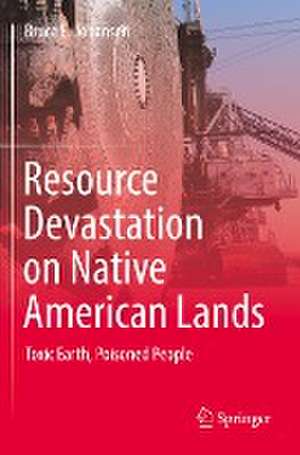Resource Devastation on Native American Lands: Toxic Earth, Poisoned People
Autor Bruce E. Johansenen Limba Engleză Paperback – 10 feb 2024
The book links present-day Native American cultural and economic revival to a fundamental struggle to restore the health of both Native peoples and their homelands. It links past and present with a sense of Native Americans’ perceptions of nature and the sacred land. By doing so, it also provides the majority society with an example to emulate as we emerge, by necessity, from the age of fossil fuels into a sustainable energy paradigm.
This makes the book a must-read for students, scholars, and researchers of Native American studies, US politics, environmental studies, public policy, as well as policy-makers interested in a better understanding of the environmental devastation of Native land and its consequences.
| Toate formatele și edițiile | Preț | Express |
|---|---|---|
| Paperback (1) | 779.61 lei 6-8 săpt. | |
| Springer International Publishing – 10 feb 2024 | 779.61 lei 6-8 săpt. | |
| Hardback (1) | 785.06 lei 6-8 săpt. | |
| Springer International Publishing – 10 feb 2023 | 785.06 lei 6-8 săpt. |
Preț: 779.61 lei
Preț vechi: 950.74 lei
-18% Nou
Puncte Express: 1169
Preț estimativ în valută:
149.20€ • 155.36$ • 126.09£
149.20€ • 155.36$ • 126.09£
Carte tipărită la comandă
Livrare economică 10-24 martie
Preluare comenzi: 021 569.72.76
Specificații
ISBN-13: 9783031218989
ISBN-10: 3031218981
Pagini: 227
Ilustrații: XI, 227 p.
Dimensiuni: 155 x 235 mm
Greutate: 0.37 kg
Ediția:1st ed. 2023
Editura: Springer International Publishing
Colecția Springer
Locul publicării:Cham, Switzerland
ISBN-10: 3031218981
Pagini: 227
Ilustrații: XI, 227 p.
Dimensiuni: 155 x 235 mm
Greutate: 0.37 kg
Ediția:1st ed. 2023
Editura: Springer International Publishing
Colecția Springer
Locul publicării:Cham, Switzerland
Cuprins
Chapter 1. Introduction.- Chapter 2. Land of the Toxic Turtles.- Chapter 3. The Deadly Yellow Dirt.- Chapter 4. Pig-shit Showers: A Neighbourly Stench.- Chapter 5. An Ice World Melts.- Chapter 6. The Inuit (and Others): If It Swims, It’s Poison.- Chapter 7. Alberta’s Moonscape: If This Sounds Apocalyptic, It Is.- Chapter 8. Mining: Angering the Water Babies and Tearing at Mother’s Breast.
Notă biografică
Bruce E. Johansen is a Frederick W. Kayser research professor emeritus for Communication and Native American Studies at the University of Nebraska at Omaha, USA, where he taught and researched from 1982 to 2019, then retired with emeritus status. Johansen has earned a national and international reputation as a scholar and interpreter of Native American history and present-day concerns, as well as environmental issues, most notably global warming and toxic chemical pollution. Johansen’s writing has been published, debated, and reviewed in many academic venues, among them the William and Mary Quarterly, American Historical Review, Current History, and Nature, as well as in many popular newspapers and magazines, such as The New York Times and The National Geographic. An expert and prolific writer on the topic, he has published several books with a related thematic focus, such as Environmental Racism in the United States and Canada (Praeger, 2020) and Seattle’s El Centro de la Raza: Martin Luther King, Jr.’s Living Laboratory (Lexington, 2020).
Textul de pe ultima copertă
This book focuses on the toxic legacy of Native North America, which is pervasive but largely invisible to most non-Native peoples. Many toxic sites are located in out-of-the-way rural areas largely forgotten by the majority of America, but which nonetheless have supplied its industries with the rudiments of manufacturing for the better part of a century before being closed and cast aside. Thousands of contaminated sites exist in the United States due to dumped, left out, or otherwise improperly managed hazardous waste. These sites include manufacturing facilities, processing plants, landfills, and mining sites. Based on the 1980 Comprehensive Environmental Response, Compensation and Liability Act (CERCLA), the US Environmental Protection Agency (EPA) cleans up these so-called Superfund sites, of which roughly 40 percent are located in Native country.
The book links present-day Native American cultural and economic revival to a fundamental struggle to restore the health of both Native peoples and their homelands. It links past and present with a sense of Native Americans’ perceptions of nature and the sacred land. By doing so, it also provides the majority society with an example to emulate as we emerge, by necessity, from the age of fossil fuels into a sustainable energy paradigm.
This makes the book a must-read for students, scholars, and researchers of Native American studies, US politics, environmental studies, public policy, as well as policy-makers interested in a better understanding of the environmental devastation of Native land and its consequences.
Caracteristici
Offers a comprehensive account of environmental disasters in Native American homelands Presents empirical evidence of the deadly environmental atrocities which affect Native peoples Provides national and international context for these disasters
